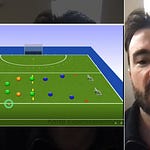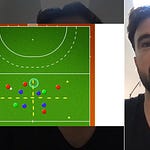When it comes to practical, game-changing insights for field hockey coaches, this workshop repeatedly hammered home one timeless fundamental: the art of effective double-teaming in defense, both technically and tactically. If you take away only one lesson from Russell Coates’ presentation, let it be this: double-teaming isn’t just about numerical superiority around the ball; it’s about timing, communication, and clarity of roles in high-pressure moments.
Double-teaming, or “doubling up,” is something every field hockey coach knows is important, but how often do we actually isolate the skill, break it down, and ingrain the specifics into our players? Russell Coates was unapologetic about this need. He started from the ground up: building simple one-versus-two drills not just for repetition, but for establishing a shared tactical language, body positioning, and defensive discipline.
Why is this so important day to day? Because, as Coates put it:
The chance of winning the ball back in a 1 versus 2 is a lot higher than in a 1 versus 1.
But in order to do that, you have to make sure it’s a one versus two and not a double one versus one. That distinction is everything: too often, a so-called double team is just two defenders diving in as individuals, each trying to claim the ball for themselves. The result? Fouls, gaps, and a highway to the D for skillful attackers.
So, how do we integrate this focus into daily practice?
Start with the basics: Open sessions with 1v2 or 2v3 scenarios in a controlled tackling box, before you even let them loose in a half-pitch or full-pitch game. Isolate double-teaming, let players learn roles—who presses, who tackles, who communicates, and when.
Hammer communication: Assign clear, unmistakable cues and language for who is pressing and who is tackling. If your squad has a multicultural mix (as most do), standardize the terms. Make “You!” or its language equivalent, and always have your spare (free man) shouting their readiness to double.
Prioritize timing and spacing: Teach your defenders to create a “V-shape”—one pressing to force the attacker’s head down or channel them, the other poised and ready to pounce. Practice waiting for that critical moment: not lunging when the attacker’s head is up, but closing when their vision drops.
Build from the back: Incorporate your goalkeepers and outletting into the process, ensuring double-teaming isn’t only a sideline skill but a core feature of every defensive set-up—central, baseline, or transitional.
Reward and penalize in training: If you’re struggling to keep defenders disciplined (diving in headlong, getting eliminated), do what Russell Coates does. “If a player gets eliminated, they have to leave the pitch for 30 seconds,” he notes. Make the stakes tactical, so every lunge is considered.
Integrate double-teaming as an intentional, explicit skill to be drilled, discussed, and evaluated—not just assumed. Watch how your side starts to hunt in packs, win more turnovers in dangerous areas, and concede fewer soft corners or easy circle entries.
“One of the main principles we’re working on at the moment... the minimal result is you want to draw—not draw as in match result, but in a one versus one, the minimal thing you go for is to draw the one versus one. So make sure you’re not eliminated.” – Russell Coates
Why every field hockey coach will want to see the whole video
The true value of this workshop lies in its granular detail and real-world coaching scenarios. Russell Coates doesn’t just talk tactics; he brings practical illustrations, video analyses of both mistakes and successes, and variations that cover everything from youth sessions to senior high-performance environments. If you want to hear candid discussion on how to correct defender ball-watching, avoid communication breakdowns, and encourage discipline and smart aggression—and see actual drills you can lift for tonight’s session—you’ll want to dive into the full session. Plus, the audience Q&A tackles the real challenges coaches face every week.
Unlock the deeper insights behind the paywall (only paid subscribers get to read on from here) to get the three most impactful takeaways and how you can implement them directly in your daily coaching.












